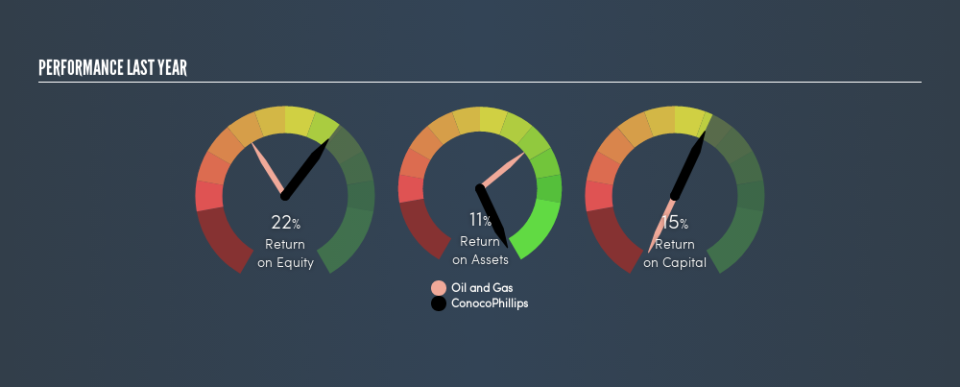Are ConocoPhillips’s (NYSE:COP) High Returns Really That Great?

Today we'll evaluate ConocoPhillips (NYSE:COP) to determine whether it could have potential as an investment idea. Specifically, we'll consider its Return On Capital Employed (ROCE), since that will give us an insight into how efficiently the business can generate profits from the capital it requires.
Firstly, we'll go over how we calculate ROCE. Next, we'll compare it to others in its industry. Last but not least, we'll look at what impact its current liabilities have on its ROCE.
What is Return On Capital Employed (ROCE)?
ROCE is a measure of a company's yearly pre-tax profit (its return), relative to the capital employed in the business. All else being equal, a better business will have a higher ROCE. Ultimately, it is a useful but imperfect metric. Renowned investment researcher Michael Mauboussin has suggested that a high ROCE can indicate that 'one dollar invested in the company generates value of more than one dollar'.
So, How Do We Calculate ROCE?
The formula for calculating the return on capital employed is:
Return on Capital Employed = Earnings Before Interest and Tax (EBIT) ÷ (Total Assets - Current Liabilities)
Or for ConocoPhillips:
0.15 = US$9.6b ÷ (US$71b - US$7.4b) (Based on the trailing twelve months to March 2019.)
So, ConocoPhillips has an ROCE of 15%.
Want to participate in a short research study? Help shape the future of investing tools and you could win a $250 gift card!
View our latest analysis for ConocoPhillips
Is ConocoPhillips's ROCE Good?
When making comparisons between similar businesses, investors may find ROCE useful. ConocoPhillips's ROCE appears to be substantially greater than the 7.6% average in the Oil and Gas industry. I think that's good to see, since it implies the company is better than other companies at making the most of its capital. Regardless of where ConocoPhillips sits next to its industry, its ROCE in absolute terms appears satisfactory, and this company could be worth a closer look.
ConocoPhillips delivered an ROCE of 15%, which is better than 3 years ago, as was making losses back then. This makes us wonder if the company is improving.
When considering this metric, keep in mind that it is backwards looking, and not necessarily predictive. ROCE can be deceptive for cyclical businesses, as returns can look incredible in boom times, and terribly low in downturns. ROCE is only a point-in-time measure. Remember that most companies like ConocoPhillips are cyclical businesses. Future performance is what matters, and you can see analyst predictions in our free report on analyst forecasts for the company.
ConocoPhillips's Current Liabilities And Their Impact On Its ROCE
Liabilities, such as supplier bills and bank overdrafts, are referred to as current liabilities if they need to be paid within 12 months. The ROCE equation subtracts current liabilities from capital employed, so a company with a lot of current liabilities appears to have less capital employed, and a higher ROCE than otherwise. To counter this, investors can check if a company has high current liabilities relative to total assets.
ConocoPhillips has total assets of US$71b and current liabilities of US$7.4b. As a result, its current liabilities are equal to approximately 10% of its total assets. Current liabilities are minimal, limiting the impact on ROCE.
What We Can Learn From ConocoPhillips's ROCE
This is good to see, and with a sound ROCE, ConocoPhillips could be worth a closer look. ConocoPhillips shapes up well under this analysis, but it is far from the only business delivering excellent numbers . You might also want to check this free collection of companies delivering excellent earnings growth.
For those who like to find winning investments this free list of growing companies with recent insider purchasing, could be just the ticket.
We aim to bring you long-term focused research analysis driven by fundamental data. Note that our analysis may not factor in the latest price-sensitive company announcements or qualitative material.
If you spot an error that warrants correction, please contact the editor at editorial-team@simplywallst.com. This article by Simply Wall St is general in nature. It does not constitute a recommendation to buy or sell any stock, and does not take account of your objectives, or your financial situation. Simply Wall St has no position in the stocks mentioned. Thank you for reading.

 Yahoo Finance
Yahoo Finance 
